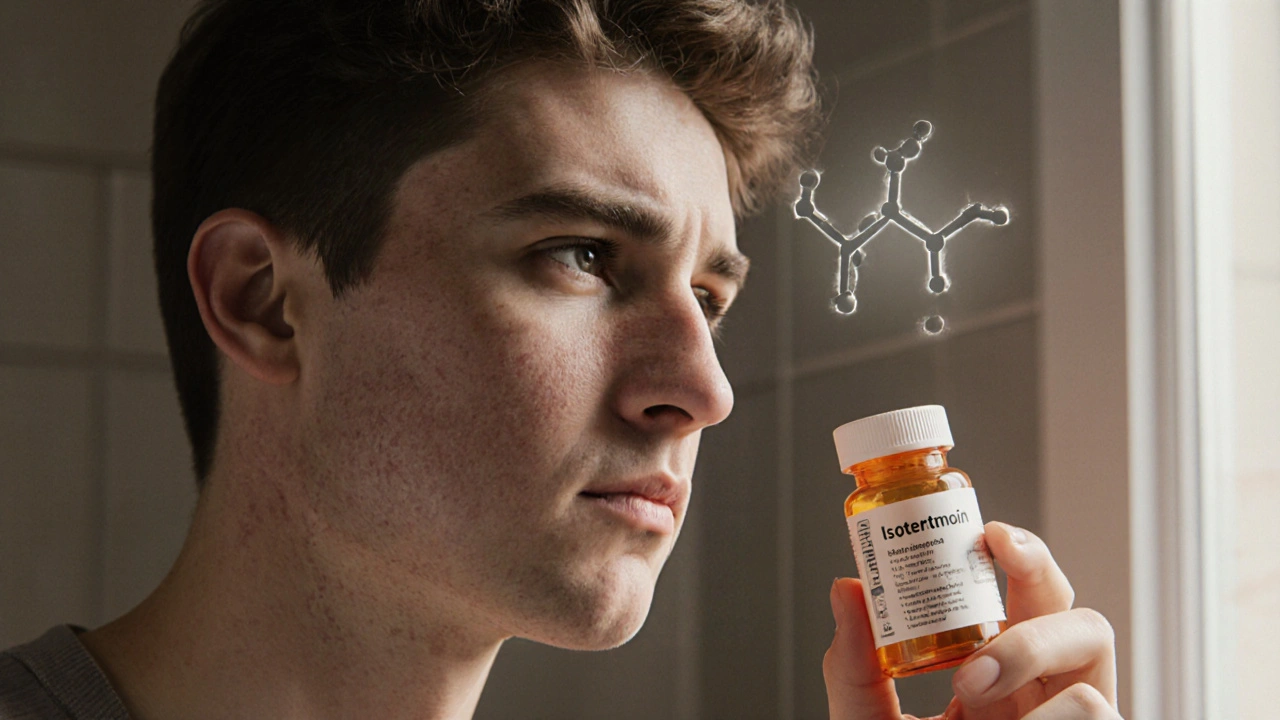Acne Treatment Decision Tool
Find Your Best Treatment Option
Answer a few questions to get personalized acne treatment recommendations based on your specific situation.
Treatment Recommendations
Important Note: These recommendations are for informational purposes only. Always consult with a dermatologist for personalized medical advice and treatment.
When acne reaches a stage where over‑the‑counter creams no longer work, many people wonder whether the powerful drug Isotretinoin is the only answer. The truth is that a range of alternatives-oral antibiotics, hormonal agents, and topical retinoids-can deliver solid results with different risk profiles. This guide breaks down the most common options so you can match the right treatment to your skin, lifestyle, and medical history.
Key Takeaways
- Isotretinoin is the most effective single drug for severe nodular acne but carries strict pregnancy restrictions and potential systemic side effects.
- Oral antibiotics such as doxycycline work well for inflammatory acne and are easier to start, yet resistance and gut flora disruption are concerns.
- Hormonal therapies (e.g., spironolactone) are especially useful for adult female patients with hormonal acne and have a favorable long‑term safety profile.
- Topical retinoids (tretinoin, adapalene) address comedonal lesions with minimal systemic impact but may cause irritation when first used.
- Cost, treatment length, and monitoring requirements differ dramatically; a clear comparison helps you decide what fits your budget and schedule.
What Is Isotretinoin?
Isotretinoin is a synthetic retinoid derived from vitamin A that targets all four major acne pathways: excess sebum production, follicular hyperkeratinization, bacterial overgrowth, and inflammation. Typically prescribed as a 0.5-1mg/kg daily dose for 4-6months, it can shrink sebaceous glands permanently, leading to long‑lasting clear skin for many patients.
Because it circulates systemically, isotretinoin demands careful monitoring. Blood lipids, liver enzymes, and pregnancy tests are checked regularly. The drug is contraindicated in pregnancy due to a >95% risk of severe birth defects, and women of child‑bearing potential must enroll in a risk‑management program.
Common Alternatives Overview
Below are the six most frequently used alternatives, each introduced with a microdata definition for easy reference.
Doxycycline is a broad‑spectrum tetracycline antibiotic that reduces acne inflammation by inhibiting bacterial protein synthesis and exerting anti‑inflammatory effects.
Spironolactone is a potassium‑sparing diuretic with anti‑androgen properties; it blocks androgen receptors in the skin, lowering sebum output.
Tretinoin is a topical retinoid that normalizes skin cell turnover, preventing clogged pores.
Adapalene is a synthetic topical retinoid formulated for better stability and lower irritation, ideal for daily over‑the‑counter use.
Benzoyl Peroxide is a topical oxidizing agent that kills acne‑causing bacteria and gently peels the skin’s surface.
Azelaic Acid is a naturally occurring dicarboxylic acid that reduces both bacterial growth and pigmentation, making it useful for post‑inflammatory hyperpigmentation.

Side‑by‑Side Comparison
| Parameter | Isotretinoin | Doxycycline | Spironolactone | Tretinoin | Adapalene |
|---|---|---|---|---|---|
| Mechanism | Systemic retinoid - reduces sebum, normalizes keratinization, anti‑inflammatory | Antibiotic - inhibits bacterial protein synthesis, anti‑inflammatory | Anti‑androgen - blocks androgen receptors, lowers sebum | Topical retinoid - accelerates cell turnover | Topical retinoid - similar to tretinoin, more stable |
| Typical Dose / Application | 0.5-1mg/kg oral daily (4-6months) | 100mg oral once or twice daily (3-6months) | 50-200mg oral daily (continuous) | 0.025-0.1% cream, nightly | 0.1% gel, nightly |
| Treatment Duration | 4-6months (often curative) | 3-6months (may need cyclic therapy) | Months to years (maintenance) | 12weeks to assess effectiveness | 12weeks to assess effectiveness |
| Efficacy for Severe Acne | 90‑95% achieve clear or near‑clear skin | 30‑50% moderate improvement | Effective for hormonal acne, less for nodular lesions | Best for comedonal acne, limited for nodules | Similar to tretinoin, better tolerance |
| Major Side Effects | Dry skin, cheilitis, elevated lipids, mood changes, teratogenicity | Photosensitivity, GI upset, yeast overgrowth | Hyperkalemia, menstrual irregularities, breast tenderness | Skin irritation, peeling, erythema | Less irritation than tretinoin, occasional dryness |
| Pregnancy Risk | Highly teratogenic - strict contraception required | Generally safe, but avoid during first trimester if possible | Contraindicated - risk of feminization of male fetus | Category C - use caution, avoid if pregnant | Category C - avoid if pregnant |
| Typical Cost (US$) | $150‑$300 per month (generic)≈$600‑$1800 total | $20‑$40 per month | $10‑$25 per month | $30‑$80 per tube (3‑month supply) | $25‑$50 per tube (3‑month supply) |
How to Choose the Right Option
Picking a therapy isn’t a one‑size‑fits‑all decision. Consider these three practical lenses:
- Severity and lesion type. Nodular or cystic acne that has failed topical regimens usually warrants isotretinoin. Predominantly comedonal or mild‑to‑moderate inflammatory acne often responds to topical retinoids plus benzoyl peroxide.
- Safety profile for your personal situation. If you’re planning pregnancy or are nursing, isotretinoin and spironolactone are off‑limits. In such cases, doxycycline (with a reliable birth‑control method) or azelaic acid become safer bets.
- Commitment to monitoring. Isotretinoin requires monthly blood work and strict pharmacy reporting. Oral antibiotics need less frequent labs but still benefit from liver function checks if used long‑term.
Discuss these points with a dermatologist who can tailor the dose, combine therapies (e.g., low‑dose isotretinoin + topical retinoid), and set realistic timelines.
Practical Tips for Managing Side Effects
- For isotretinoin dryness, use a gentle, fragrance‑free cleanser and a thick moisturizer containing ceramides. Apply sunscreen SPF30+ daily to counter photosensitivity.
- When starting doxycycline, take the pill with food and maintain adequate hydration to reduce stomach upset.
- Spironolactone users should have serum potassium checked after the first month; a low‑sodium diet helps prevent hyperkalemia.
- Begin topical retinoids with a “start low, go slow” approach: apply two‑times‑week, gradually increasing to nightly as tolerated.
When to Escalate to Isotretinoin
Even if you begin with a milder alternative, certain red flags suggest it’s time to move up:
- Persistent nodules that scar or cause deep pits.
- Failure to improve after 12‑16weeks of appropriate antibiotic or hormonal therapy.
- Rapidly worsening acne that impacts mental health.
In these scenarios, a dermatologist will assess baseline labs, ensure effective contraception, and outline the expected course of isotretinoin therapy.
Bottom Line
Isotretinoin remains the gold standard for severe, refractory acne, but its potency comes with strict safety demands. For many patients-especially those who are pregnant, have mild‑to‑moderate disease, or prefer a lower‑risk approach-alternatives like doxycycline, spironolactone, and modern topical retinoids provide solid outcomes with fewer systemic worries. Use the comparison table as a quick reference, weigh your personal health factors, and involve a skin specialist to land on the most suitable plan.
Frequently Asked Questions
Can I use isotretinoin and oral antibiotics together?
Yes, doctors sometimes combine a low‑dose isotretinoin with doxycycline to speed up clearing of inflammatory lesions while keeping the overall isotretinoin dose lower. This combo still requires monthly labs and strict birth‑control.
Is spironolactone effective for teenage boys?
Spironolactone works by blocking androgen receptors, so it’s primarily used for females with hormonal acne. In teenage boys it can cause unwanted breast tissue growth and is generally avoided.
How long does it take to see results with adapalene?
Most users notice a reduction in new breakouts after 4‑6weeks, but full improvement in texture and comedones can require 12weeks of consistent nightly use.
What monitoring is required for isotretinoin?
Baseline liver enzymes, fasting lipid panel, and a pregnancy test are mandatory. Follow‑up labs are typically done every 4weeks to track liver function, triglycerides, and cholesterol. If any values rise sharply, the dose may be lowered or the course paused.
Are there over‑the‑counter alternatives that work as well as prescription meds?
OTC options like benzoyl peroxide, salicylic acid, and adapalene 0.1% gel can control mild to moderate acne effectively, but they rarely match the clearance rates of prescription isotretinoin or oral antibiotics for severe disease.

Mary Magdalen
October 12, 2025 AT 04:15Isotretinoin is often glorified like it’s the holy grail of acne, but the side‑effects are a ticking time‑bomb that most patients ignore until it explodes on their skin and psyche.
Dhakad rahul
October 17, 2025 AT 23:08Behold! The saga of the red‑spot tyrant – a drama worthy of a Shakespearean tragedy! 🌟 Isotretinoin wields power like a sorcerer’s wand, yet it demands the sacrifice of a flawless future. 🤯
William Dizon
October 23, 2025 AT 18:01Hey folks, just wanted to add a quick practical note: if you’re starting isotretinoin, make sure you have a reliable birth‑control method and schedule monthly labs for liver enzymes and lipids. Also, using a gentle, fragrance‑free moisturizer can really tame that dreaded dryness. Pairing the treatment with a sunscreen of SPF 30+ is essential because the skin becomes extra photosensitive.
Ira Bliss
October 29, 2025 AT 12:55💪✨ Keep your chin up, acne warriors! Staying hydrated and using a ceramide‑rich moisturizer can turn the isotretinoin desert into an oasis. Remember, consistency is key – don’t skip that SPF and you’ll protect your skin while it heals. 🌞🚀
Michael GOUFIER
November 4, 2025 AT 07:48Dear Ms. Bliss, your encouragement is much appreciated. In addition to your suggestions, I would advise patients to integrate a non‑comedogenic sunscreen into their routine to mitigate photosensitivity. Moreover, a gradual introduction of moisturizers can alleviate the mucocutaneous dryness associated with isotretinoin therapy.
michael Mc Laughlin
November 10, 2025 AT 02:41yeah its cool just remember to drink water and use a good moisturizer
Aakash Jadhav
November 15, 2025 AT 21:35Oh, the existential dread of a breakout! One might argue that acne is the universe’s way of reminding us we’re still mortal, yet isotretinoin promises a fleeting glimpse of immortality-if only we survive the tempest.
Amanda Seech
November 21, 2025 AT 16:28i think the best way to start is to talk with a skin doc and see what fits ur budget and life style. isotretinoin is powerful but not for evryone.
Lisa Collie
November 27, 2025 AT 11:21While many hail isotretinoin as the ultimate solution, let’s not forget that the hype often masks the real risk profile-particularly for those who might not be able to maintain strict contraception.
Scott Shubitz
December 3, 2025 AT 06:15Honestly, the data shows isotretinoin clears severe acne at a 90% rate, but the side‑effects-dry eyes, depression, teratogenicity-are not just footnotes; they’re headline material.